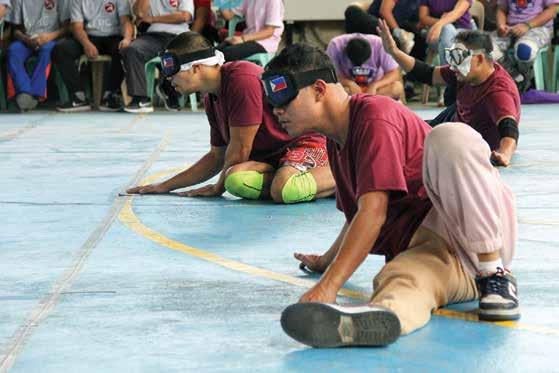
9 minute read
Can interfaith collaborations stop hate...
and peace in life is not from conquering others, but through love and mutual respect.”
A Buddhist approach
Advertisement
At the beginning of each year, Abbot Dong’s temple conducts the Prayer for World Peace, which brings together religious leaders from several different faiths. Throughout the year, people from diverse backgrounds come to various cultural events such as the Lunar New Year Celebration, or even to plant trees and clean up beaches.
“These events bridge people from different ethnic and religious backgrounds,” he said. “The best way to solve the problem of hate is to correct it from its root, to seize the causes of hate in people’s minds and change the conditions by switching from a hateful atmosphere to a moral and kind environment.”
Abbot Dong was joined by three other faith leaders at an April 19 news briefing organized by the Act Against Hate Alliance, founded by Mei Mei Huff and her husband, former California State Senator Bob Huff. The panelists focused on the ability of interfaith collaborations to mitigate hate incidents and attacks, emphasizing that people of different backgrounds need to understand other people’s creeds and lived experiences, and to stand up for them when there is conflict.
Religious pluralism Colleges and universities are the one place where people from very different religious, cultural, and socio-economic backgrounds inherently come together, said Dr. Dawn Michele Whitehead, Vice President of the Office of Global Citizenship for Campus, Community, and Careers at the American Association of Colleges and Universities, and co-director of the Interfaith Leadership in Higher Education initiative.
“We often see students coming together in intentional activities when we’re talking about race, ethnicity, gender, but we don’t always include religion,” she said. Whitehead’s organization, Interfaith America, looks at ways to help students prepare for interfaith cooperation and interfaith engagement.
“One of the first things we do is we talk about the concept of a world view, a foundational outlook that an individual has on life to help make sense of the world,” said Whitehead, stressing the goal of building a more religiously pluralistic society. “And our goal in our work, not just for our project, but for society, is to really see ourselves in a world where people of differing worldviews and religions can live together in peace and maintain their distinctiveness.”
Intertwined threads
“The United States may be one of the most religiously diverse countries, but we may also be one of the most religiously illiterate. And this is something that we must acknowledge and offer our students meaningful, intentional opportunities to learn and engage from each other across religious differences,” she said.
Rabbi Sarah Hronsky, President of the Board of Rabbis of Southern California, said:
“There is so much benefit to not just stand on one’s religious pulpit to beat one’s theology, but rather to go to the find the bridges and the connections between these religious groups so we can stand united against all hate.”
“As I learned in the Navy, much like threads, when you put nine or ten threads together, when you wrap them together and intertwine them, they’re much stronger than they are singly by themselves,” said Dr. Mohammed Zuhdi Jasser, President and founder, American Islamic Forum for Democracy, who served in the US military.
“One of the best ways for us to do that is to demonstrate what genuine reform within our communities is in combating faith-based hate that might exist within our community,” he said. “One does not build community by demonizing another.” (Sunita Sohrabji/Ethnic Media Services)
Sara: Time to end insurgency...
her responsibilities as education secretary.
“We fear that with (her) appointment as the co-vice chair of the NTF-ELCAC, her red-tagging activities will get worse and will continue to undermine teachers’ freedom of association and human rights,” said Raymond Basilio, secretary-general of the Alliance of Concerned Teachers (ACT).
“Given the magnitude of unresolved issues, challenges and problems faced by DepEd, these should be prioritized by the secretary,” Basilio said, referring to the Department of Education. The ACT earlier filed a complaint against Duterte over her remarks linking the group with the communists.

Bagong Alyansang Makabayan secretary-general Renato Reyes

Jr. said Duterte should focus on problems in the education sector instead of counterinsurgency.
Karapatan secretary general
Cristina Palabay said the appointment of Duterte, whom she described as a serial and notorious red tagger, reinforces the “fascist” character of the NTF-ELCAC.
“It only shows the greater need for the abolition of this TF that has been responsible for numerous cases of human rights violations,” she said, referring to the task force.
Militant fishers’ group Pambansang Lakas ng Kilusang Mamamalakaya ng Pilipinas (Pamalakaya) is also wary of Duterte’s appointment given her background.
A RESEARCH scientist who works on the intersection of reasoning and machine learning likens the boom in artificial intelligence to the Industrial Revolution.
“I wasn’t around then,” says Hector Palacios, “but back in the day people would say, ‘I’m going to buy an engine.’” After a while, nobody was thinking about engines, Palacios says. Engines powered machinery “to become many specialized things in many contexts.”
AI has been evolving for decades, but the recent unveiling of chatbots that write scientific papers, legal briefs, and news stories has many fearing that a robot will someday replace them. Still, others point to AI’s potential to revolutionize fields like education, journalism, and science.
FTC chair Lina Khan recently summed up the contradictions inherent in this burgeoning technology when she said that AI can deliver critical innovation, but also “turbocharge fraud and automate discrimination.”
Vice-President Kamala Harris waded into the debate when she met last week with chief executives of four Big Tech firms to discuss artificial intelligence.
In a statement after the three-hour meeting, the administration said there had been “frank and constructive discussion” about companies being more open about their products and the importance that those products be kept away from bad actors.
Ramping up misinformation
“It used to be the case that we saw some text quickly, and said, ‘Oh, yes, that was fully written by a human’. But this is not true anymore,” Palacios says.
For example, the Republican National Committee released a 30-second spot last week in response to President Biden’s announcement that he was running for reelection. The ad showed fake visuals of China invading Taiwan and 80,000 immigrants overwhelming the Southern border, all of it interspersed with disturbing footage of civic unrest.
A barely noticeable disclaimer along the upper left-hand corner of the screen read: “Built entirely with AI imagery.”
“Artificial intelligence is software,” Palacios told reporters during a news briefing last week, noting the technology is based on math, which can do complex computing that algorithms take one step further with large language models (LLMs).
Generative AI uses computers and LLMs to create new content from large sets of data. LLMs are designed specifically to generate text-based content.
Dr. Christopher Dede is a senior research fellow at Harvard’s Graduate School of Education and Associate Director of Research for the National AI Institute for Adult Learning and Online Education. When he reads a student essay that is just too good to believe, Dede doesn’t worry about it too much. Plagiarism has been around a lot longer than LLMs.
“So, at the start of the spring semester in my online course at Harvard, I spent 5 minutes talking to students about generative AI and I said, ‘You can use generative AI, and if you’re smart about it, we’re not going to be able to tell.’”
But when they go out for a job interview and are asked to produce a marketing plan in half an hour, he warns them, “If your marketing plan isn’t a lot better than what comes out of the AI, you’re not going to get hired.”
Seeing AI as a partner Dede tells his students to think about AI as a partner, not as a substitute, an insight he came to as a young graduate student who loved Star Trek.
“In Star Trek, the Next Generation, where you have Captain Picard, the wise human starship captain, and then you have Data who looks like a person, but is actually an android, a machine.”
“Data is capable of absorbing enormous amounts of data in a matter of a seconds, and doing what’s called reckoning, which is calculative prediction. Captain Pickard has sort of judgment-applied wisdom, and so he’s the one that’s in charge of the starship, and he uses Data’s calculative predictions to help him make good decisions.”
Dede says Data augmented Picard’s human experience and the two partners did things together neither could do by themselves.
“To illustrate this in a less fantastic way, there are cancer specialists, oncologists now who have AI partners. The AI can do something that no cancer specialist can do.
It can scan every morning 1,500 medical journals online and see if there’s something new about the treatment of a particular patient. It can scan medical records worldwide of similar patients undergoing a variety of treatments and get advice about what’s working and what’s not working,” he says.
But you would never want the AI making the decisions because the doctor knows things the AI doesn’t know. The doctor knows about pain and death. The doctor understands that cultures have different points of view about death, its effects on family as well as an individual, and so on.
“AI does not understand any of those things. It’s an alien kind of intelligence,” Dede says. And sometimes it really blows it.
Tracking AI bloopers
Sean McGregor got his PhD in machine learning. He was the lead technical consultant for the IBM Watson AIXPRIZE and founded the Responsible AI Collaborative. He is developing an AI Incident Database to index AI performance in the real world.
Basically, McGregor scours the world for AI bloopers.
One woman in China was publicly shamed for jaywalking when AI picked up her image on the side of a bus. In 2021, a man in Bath, England was cited for driving in a bus lane after AI captured a photo of a woman wearing a shirt that said “KNI9TER.” It looked a lot like the man’s license plate.
“What the database does is it collects each of these incidents that happen in the world and puts a number to them.” The goal, says McGregor, is to “make the whole AI industry safer.”
In the meantime, Palacios says the existential tenor of discussions around AI’s potential applications and impacts misses a finer point.
“Many things are going to happen with the AI revolution and probably the biggest surprises are going to come in the small details.”
As US emergency declarations end, access to COVID...
its supply of COVID-19 vaccines and treatments, Paxlovid and Molnupiravir, available to residents at no cost regardless of a person’s insurance coverage.
In California, new laws require insurance plans, including Medicare or Medi-Cal, to cover the cost of vaccines, testing and Paxlovid for COVID-19 treatment through Nov. 11, 2023. Exact coverage may vary depending on an individual's insurance plan.
Residents without insurance may receive free at-home test kits or PCR tests for COVID-19 at public health clinics and vaccination sites, at community health centers or purchase tests from a local retailer. People who are uninsured can visit coveredca.com to see if they qualify for Medi-Cal or Covered California coverage.
Public Health’s Call Center will continue to operate, connecting eligible residents to free telehealth, homebound vaccination appointments, COVID-19 information and other resources. Residents are encouraged to call 1-833-5400473, available daily between 8 a.m. to 8:30 p.m., to access these services. The 7-day average number of COVID hospitalizations is 252 this week, similar to the 266 reported last week. Reported weekly deaths also remained stable at 46 deaths this week; this is slightly less than the 51 deaths reported last week.
“To those in Los Angeles County who have lost a loved one to COVID-19, I offer my sincere condolences and hope you find comfort,” said Dr. Barbara Ferrer, Ph.D., M.P.H., M.Ed., Director of the Los Angeles County Department of Public Health. “We are grateful that Los Angeles
County is in a better place and that emergency declarations are no longer needed. I am aware that each day thousands of people throughout Los Angeles County continue to be impacted by COVID-19, whether they need to miss work due to illness, require hospital care, or are experiencing the effects of long COVID. Public Health remains committed to work that reduces the chance of transmission and ensures the county remains prepared for the likelihood of periodic changes in transmission. We’re continuing our work to make sure there are no barriers for anyone wishing to access lifesaving vaccines, therapeutics and tests, especially for those who are under insured or uninsured.”
Public Health will continue to sequence COVID-19 variants and strains as a part of its efforts to monitor COVID-19. XBB.1.5 remains the dominant strain in Los Angeles County accounting for 83% of sequenced specimens for the week ending April 15, 2023. The second most dominant strain was XBB.1.9.1, accounting for 7% of sequenced specimens. LA County has had 13 confirmed cases of XBB.1.16 and data from the U.S. Centers for Disease Control and Prevention (CDC) estimates that XBB.1.16 makes up 10% of cases in California and surrounding states.
CDC is retiring the COVID-19 Community Levels and will be replacing them with hospitalization metrics. Los Angeles County will closely monitor hospitalization data in alignment with CDC, along with a wide variety of additional metrics available on its website.
As of Tuesday, May 9, there have been a total of 36,291 deaths in Los Angeles County. (AJPress)




